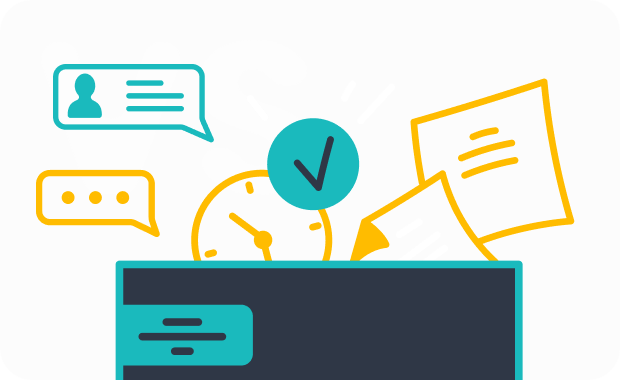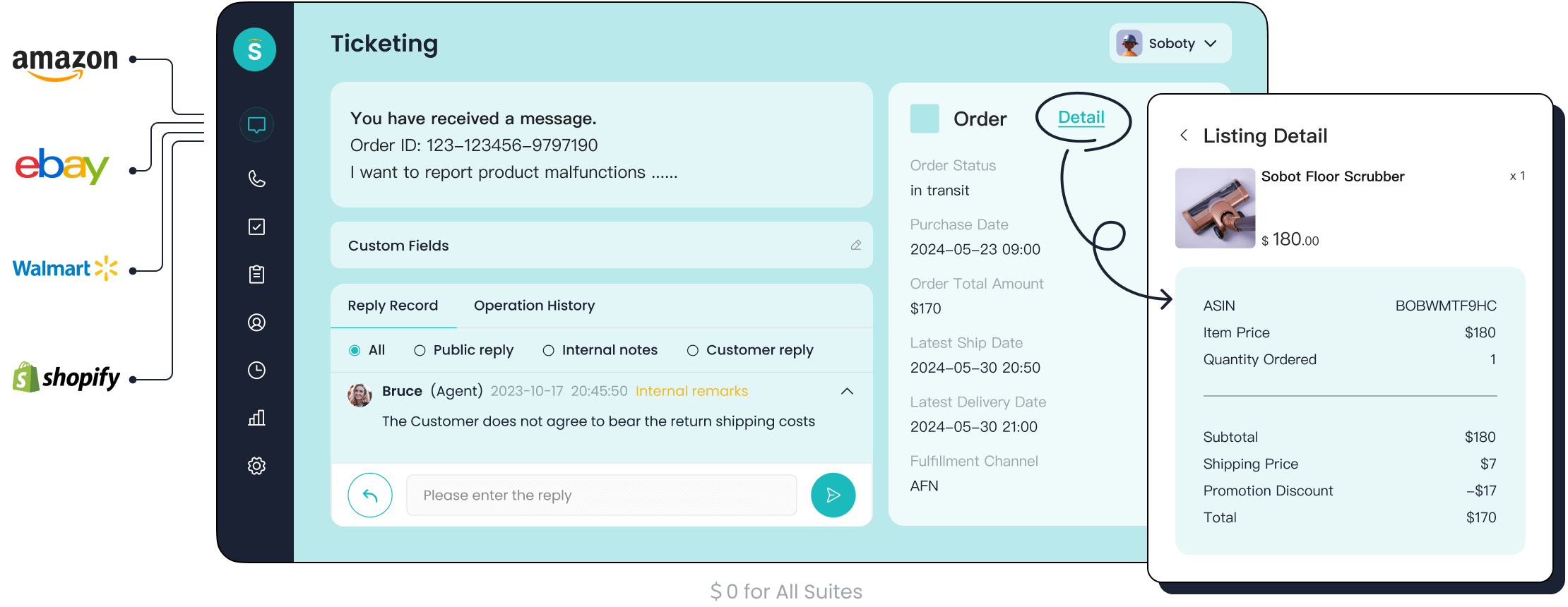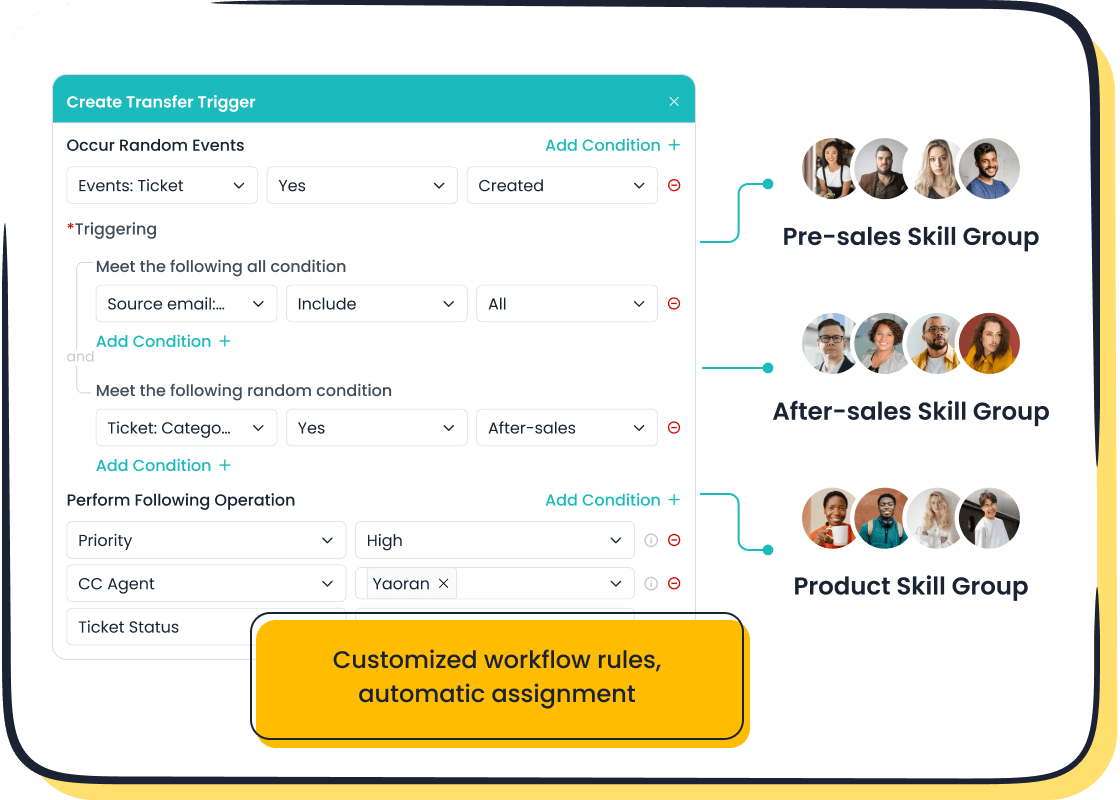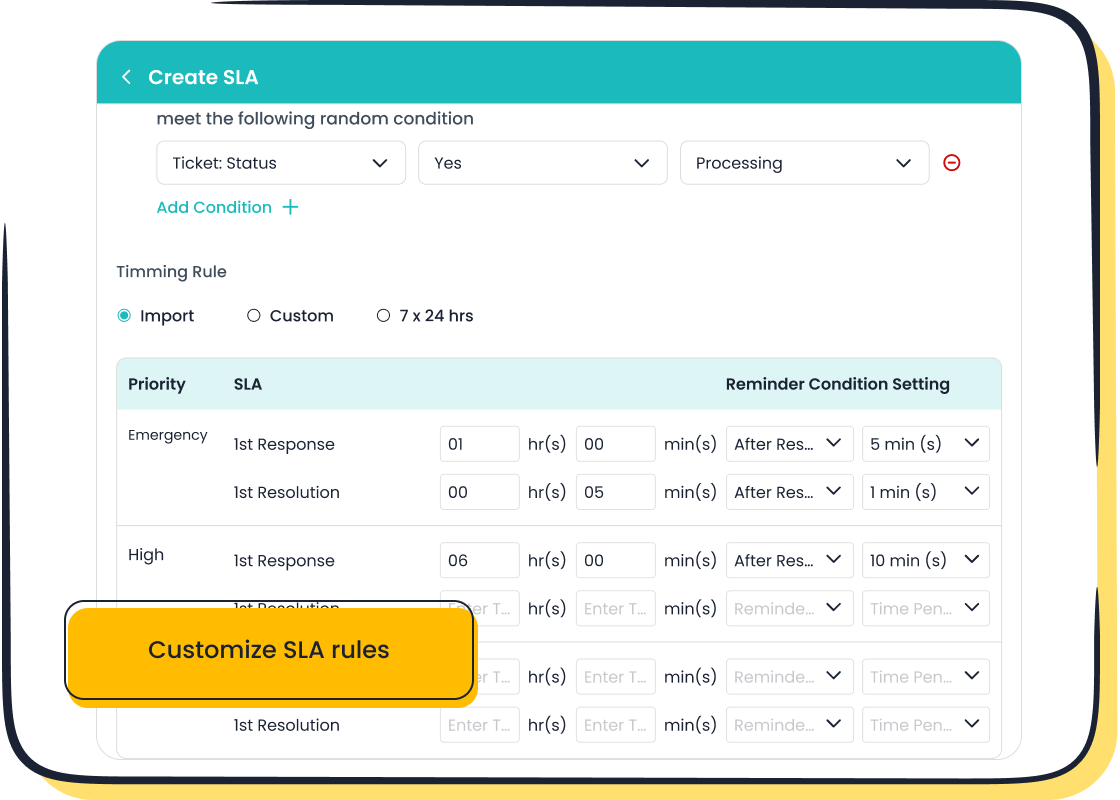Understanding the Benefits of Ticketing Systems for Support Teams

A customer service ticketing system simplifies how you manage customer inquiries. It organizes requests into tickets, making it easier to track and resolve issues. This tool ensures no query gets overlooked, improving your team's efficiency. For example, Sobot's ticketing system integrates email, voicemail, and chat into one platform. It automates ticket routing and prioritization, saving time and reducing errors. Businesses using such systems often see faster response times and higher customer satisfaction. The advantages of using a ticketing system for customer service include better communication, streamlined workflows, and personalized support.
What Is a Customer Service Ticketing System?
Definition and Purpose
What is a ticket in customer service?
A ticket in customer service represents a record of a customer's inquiry or issue. It contains all the necessary details, such as the customer's contact information, the nature of the problem, and any relevant communication history. Tickets help support teams track and manage customer interactions efficiently. For example, when a customer emails about a delayed order, the system creates a ticket with all the details. This ensures the issue is addressed promptly and accurately.

Why do support teams need a customer service ticketing system?
Support teams need a customer service ticketing system to handle inquiries systematically. These systems organize tickets by priority, type, or urgency, allowing teams to focus on critical issues first. They also improve efficiency by automating repetitive tasks like ticket assignment and status updates. Analytics from these systems provide insights into response times and resolution rates, helping teams identify areas for improvement. For instance, Sobot's customer support ticketing system integrates email, voicemail, and chat, ensuring no query is missed while streamlining workflows.
How Ticketing Systems Work
The process of creating, assigning, and resolving tickets
The workflow of a ticketing system involves several steps:
- Ticket Creation: When a customer submits a query, the system generates a ticket with all relevant details.
- Categorization and Prioritization: The system categorizes tickets by type and urgency, ensuring critical issues are addressed first.
- Assignment: Tickets are routed to the appropriate agent based on expertise and availability.
- Tracking and Management: Agents track progress and communicate with customers through the system.
- Resolution and Closure: Once resolved, the ticket is closed, and the customer is notified.
For example, during a holiday sale, an e-commerce company can use a ticketing system to manage inquiries about delayed orders. This ensures faster resolution and better customer satisfaction.

Integration with tools like Sobot's Ticketing System and CRM platforms
Modern ticketing systems integrate seamlessly with other tools like CRM platforms. This integration allows support teams to access customer data, such as purchase history and preferences, directly within the ticket. Sobot's ticketing system excels in this area by unifying communication channels and providing a single view of the customer. It also supports integration with e-commerce platforms like Shopify, enabling businesses to streamline operations further. These features enhance efficiency and ensure personalized support for every customer.
Tip: Integration with CRM tools not only improves ticket resolution times but also helps in building long-term customer relationships.
Advantages of Using a Ticketing System for Customer Service
Improved Communication and Collaboration
Centralized communication for all customer interactions

A ticketing system centralizes all customer interactions, ensuring no message gets lost. Whether customers reach out via email, voicemail, or chat, the system consolidates these into a single platform. This unified approach simplifies issue tracking and enhances customer service ticket management. For instance, Sobot's customer support ticketing system integrates multiple channels, allowing agents to access all communication in one place. This reduces confusion and ensures quicker ticket management.
Centralized communication also improves customer satisfaction. Customers no longer need to repeat their concerns across different channels. Instead, agents can view the entire conversation history, making interactions smoother and more efficient. Studies show that companies prioritizing collaboration in customer service see a 10% improvement in customer satisfaction. This highlights the importance of a streamlined communication process.
Internal collaboration features like tagging and notes
Internal collaboration tools, such as tagging and notes, further enhance teamwork. Agents can tag colleagues for assistance or leave notes on support tickets to provide context. These features ensure seamless delegation of requests and prevent miscommunication. For example, if an agent needs help resolving a technical issue, they can tag a specialist directly within the ticket. This reduces delays and improves resolution times.
Organizations fostering collaboration also experience a 20% higher employee retention rate. This demonstrates how effective internal tools not only improve customer service but also create a supportive work environment for teams.
Efficient Ticket Management
Prioritization and categorization of tickets

Efficient ticket management begins with prioritization and categorization. A ticketing system organizes support tickets based on urgency, type, or customer profile. This ensures critical issues receive immediate attention. For example, Sobot's system uses custom triggers to classify tickets, enabling agents to focus on high-priority tasks. This structured approach leads to faster resolution and better customer satisfaction.
The benefits of prioritization are clear. Faster response times and effective handling of tickets reduce customer frustration. A well-organized system also helps teams manage their workload more effectively, ensuring no ticket gets overlooked.
Real-time tracking and reporting for better decision-making
Real-time tracking and reporting provide valuable insights into customer service operations. Metrics like resolution time, first contact resolution rate, and ticket backlog help teams identify areas for improvement. Sobot's ticketing system offers comprehensive analytics, enabling managers to monitor performance and make data-driven decisions.
| Metric | Description |
|---|---|
| Resolution Time | Average time for a ticket to be resolved, indicating efficiency in ticket management. |
| Customer Satisfaction Score (CSAT) | Rating from customers post-resolution, reflecting the effectiveness of the TMS from the user's perspective. |
| Ticket Backlog | Number of unresolved tickets, which can indicate potential issues with the TMS. |
| First Contact Resolution Rate | Percentage of tickets resolved in the first interaction, showing the team's ability to address issues quickly. |
| Agent Performance Metrics | Metrics related to individual agents, helping identify performance levels and training needs. |
These insights not only improve issue tracking but also enhance overall team productivity. By addressing bottlenecks and optimizing workflows, you can deliver exceptional customer service.
Enhanced Customer Experiences with Ticketing Systems

Faster Response Times
Automated responses and quick ticket routing

A ticketing system ensures faster response times by automating key processes. When a customer submits a query, the system instantly creates a ticket and routes it to the most suitable agent. This eliminates delays caused by manual assignment. For example, Sobot's ticketing system uses custom triggers to assign tickets based on criteria like urgency or topic. This automation allows your team to focus on resolving issues rather than sorting through inquiries.
Quick ticket routing also improves the customer service experience. Customers receive faster acknowledgment of their concerns, which builds trust and satisfaction. According to performance metrics, shorter wait times and quicker responses lead to higher customer satisfaction.
| Metric | Benefit |
|---|---|
| First Response Time (FRT) | Measures speed of initial customer engagement |
| Higher satisfaction | Quick responses lead to happier customers |
| Simple to track | FRT is easy to measure and monitor |
| Better planning | Reveals staffing needs based on response patterns |
Tip: Automating responses not only saves time but also ensures consistent communication across all channels.
Reducing wait times with Sobot's Ticketing System
Sobot's ticketing system excels at reducing wait times. Its intelligent automation features, such as SLA reminders and time-triggered actions, ensure that no ticket goes unnoticed. By integrating communication channels like email, voicemail, and chat, Sobot provides a unified platform for managing inquiries. This streamlined approach minimizes delays and enhances customer satisfaction.
Additionally, automation boosts efficiency. For instance, during peak shopping seasons, businesses using Sobot's system can handle high volumes of tickets without compromising resolution times. This ensures customers receive timely support, even during busy periods.
Personalized Support
Access to customer history and preferences
Personalized support begins with understanding your customers. A ticketing system provides agents with access to customer history and preferences, enabling them to offer tailored solutions. Sobot's system displays all relevant customer information, such as past interactions and purchase history, alongside each ticket. This comprehensive view allows agents to address issues more effectively.
For example, if a customer contacts you about a recurring issue, the system highlights previous resolutions. This saves time and ensures a smoother customer service experience. Studies show that 71% of consumers expect brands to recognize them as individuals, making personalized support a key driver of customer loyalty.
Tailored solutions for unique customer needs
Tailoring solutions to individual needs enhances the overall customer experience. With a ticketing system, agents can categorize tickets based on specific requirements, ensuring each customer receives the most appropriate support. Sobot's multilingual capabilities further personalize interactions by allowing customers to communicate in their preferred language.
| Statistic | Impact on Customer Satisfaction |
|---|---|
| 52% of consumers | Report increased brand loyalty due to personalized experiences |
| 93% of customers | More likely to return to businesses that deliver optimal service |
| 76% of shoppers | Willing to purchase from brands that personalize their experiences |

Brands like Amazon and Nike have demonstrated the power of personalization by using data analytics to recommend products and customize experiences. By adopting a ticketing system like Sobot's, you can achieve similar results, fostering loyalty and boosting customer satisfaction.
Increased Team Productivity Through Automation

Automation of Repetitive Tasks
Streamlining workflows with Sobot's Ticketing System

Automating repetitive tasks is one of the most effective ways to boost team productivity. A ticketing system like Sobot's simplifies daily operations by automating ticket creation, routing, and prioritization. This ensures that your team spends less time on manual processes and more time addressing customer needs. For instance, Sobot's system uses custom triggers to assign tickets to the right agents, eliminating delays caused by manual sorting.
Studies show that 76% of businesses use automation to standardize workflows, reducing errors and saving time. Additionally, 94% of employees regularly perform repetitive tasks that could be automated, freeing them to focus on more strategic activities. By adopting a ticketing system, you can achieve streamlined workflows and ensure your team operates at peak efficiency.
| Statistic | Description |
|---|---|
| 31% of Businesses | Fully automated at least one function, leading to time savings and accuracy |
| 65% of Knowledge Workers | Feel less stressed due to automation of manual tasks |
| 90% of Knowledge Workers | Agree automation has significantly improved their work lives |
| 76% of Businesses | Use automation to standardize daily workflows |
| 2 Out of 3 Knowledge Workers | Report increased productivity due to automation |
| 78% of Business Leaders | Believe automation enhances overall productivity |
Freeing up time for complex customer issues
Automation not only saves time but also allows your team to focus on resolving complex customer issues. By handling repetitive tasks like ticket categorization and status updates, a ticketing system ensures that your agents have more bandwidth for high-priority cases. For example, the Brastel case study revealed a 35% reduction in ticket resolution time and a 39% decrease in response time after implementing automation.
This shift enables your team to deliver better customer service while maintaining efficiency. When your agents can dedicate their energy to solving intricate problems, customer satisfaction naturally improves.
Performance Metrics and Insights
Identifying trends and bottlenecks

A ticketing system provides valuable insights into your team's performance by tracking key metrics. With real-time analytics, you can identify trends and bottlenecks that may hinder productivity. For example, Sobot's system offers detailed reports on resolution times, ticket backlog, and agent performance. These insights help you pinpoint areas that need improvement and optimize your workflows accordingly.
Data-driven decision-making enhances clarity and ensures your team stays aligned with organizational goals. By addressing bottlenecks proactively, you can maintain a high level of efficiency and customer satisfaction.
Using analytics to improve team efficiency
Analytics play a crucial role in improving team efficiency. Benchmarking your performance against industry standards helps you identify gaps and set realistic goals. Collaborative tools within a ticketing system also facilitate knowledge sharing, ensuring your team works cohesively.
For instance, Sobot's analytics dashboard provides actionable insights that empower managers to make informed decisions. By leveraging these tools, you can continuously refine your processes and achieve better outcomes for your team and customers.

Addressing Common Concerns About Ticketing Systems
Challenges in Implementation
Overcoming initial setup and training hurdles
Implementing a ticketing system can feel overwhelming at first. Many teams face challenges like unfamiliarity with the system or a lack of proper training. Employees may resist adopting the new tool, perceiving it as too complex. For example, when Reed introduced a new CRM, they received numerous support calls for basic queries. By creating self-help guides, they reduced these calls by 23% within six months.
To overcome these hurdles, focus on simplifying the onboarding process. Offer training sessions tailored to your team's needs. Use user-friendly interfaces to make the system accessible. Sobot’s ticketing system, for instance, provides intuitive features and multilingual support, ensuring a smoother transition for global teams.
Ensuring team adoption and engagement
Getting your team to embrace a ticketing system requires more than just training. Engagement plays a critical role. Employees need to see how the system benefits their daily tasks. Resistance often stems from a lack of understanding or perceived complexity. Simplify adoption by demonstrating how the system streamlines workflows and reduces manual effort.
Encourage feedback during the implementation phase. This helps identify pain points and fosters a sense of ownership among team members. Sobot’s system, with its customizable triggers and automated workflows, makes it easier for teams to adapt and stay engaged.
Integration with Existing Systems
Compatibility with CRM, email, and chat tools

A ticketing system must integrate seamlessly with your existing tools. Compatibility ensures smooth operations and prevents data silos. For instance, Sobot’s system connects with CRM platforms, email, and chat tools, providing a unified view of customer interactions. This integration simplifies communication and enhances efficiency.
Different industries benefit from such compatibility. E-commerce businesses streamline order inquiries, while healthcare providers improve patient care coordination. Educational institutions use it to manage admission queries, and hospitality services ensure prompt guest support. These examples highlight the versatility of a well-integrated ticketing system.
Seamless integration with Sobot's omnichannel solutions
Sobot’s ticketing system excels in omnichannel integration. It unifies communication channels like email, voicemail, and chat into a single platform. This eliminates the need to switch between tools, saving time and reducing errors. For example, during peak shopping seasons, businesses can handle high ticket volumes efficiently using Sobot’s system.
The system also integrates with e-commerce platforms like Shopify, ensuring a seamless flow of data. This feature enhances customer service by providing agents with all the information they need in one place. With Sobot, you can deliver consistent and personalized support across all channels.
A ticketing system transforms how you manage customer inquiries. It improves communication, streamlines workflows, and enhances customer satisfaction. Tools like Sobot's customer service ticketing system unify communication channels, automate repetitive tasks, and provide actionable insights. Businesses adopting such systems report measurable benefits: a 15% reduction in service costs and a 25% boost in customer retention. These results highlight the value of investing in robust solutions. By implementing a ticketing system, you can elevate your support operations and build stronger customer relationships.
FAQ
What is the main purpose of a ticketing system?
A ticketing system helps you organize and manage customer inquiries efficiently. It tracks issues, assigns them to the right agents, and ensures timely resolution. For example, Sobot's ticketing system automates these processes, reducing manual effort and improving response times.
Can a ticketing system handle multiple communication channels?
Yes, most modern ticketing systems, including Sobot's, integrate multiple channels like email, voicemail, and chat. This ensures all customer interactions are centralized in one platform, making it easier for you to manage inquiries and provide consistent support.
How does automation improve customer service?
Automation speeds up repetitive tasks like ticket routing and status updates. Sobot's system uses custom triggers to assign tickets automatically, saving time and reducing errors. This allows your team to focus on resolving complex issues, improving both efficiency and customer satisfaction.
Is a ticketing system suitable for small businesses?
Absolutely! A ticketing system like Sobot's scales to fit businesses of all sizes. It simplifies workflows, reduces response times, and enhances customer satisfaction, making it a valuable tool even for small teams.
How can analytics in a ticketing system benefit your team?
Analytics provide insights into performance metrics like resolution time and ticket backlog. Sobot's system offers detailed reports, helping you identify trends and bottlenecks. These insights enable you to optimize workflows and improve team efficiency.
See Also
Enhance SaaS Customer Support Using Live Chat Techniques
Excelling in Live Chat for Effective Customer Assistance
Strategies for Efficient Management of Live Chat Agents